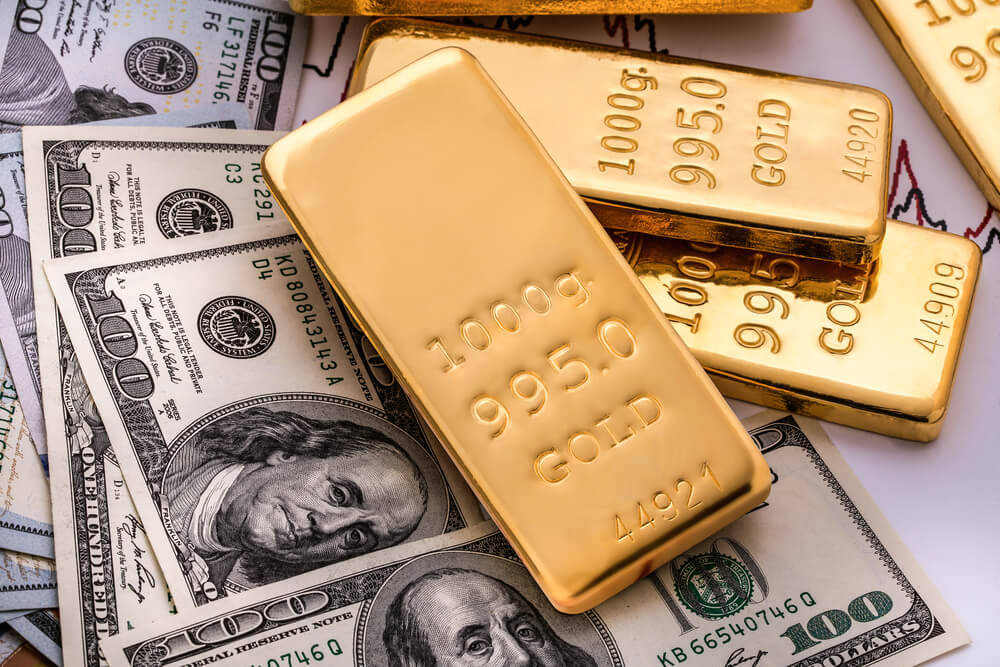For the past year, gold has been caught between two very important dynamics in the global market: an emerging safe-haven trade as asset prices rise beyond historic norms and growing U.S. dollar liquidity problems.
Wednesday’s Federal Open Market Committee meeting and press conference confirmed for the markets that the latter issue is not quieting down despite hundreds of billions in U.S. treasury bills being monetized by the Federal Reserve over the past few months.
Chair Jerome Powell extended the timeline for Fed interventions into the repo markets until at least April. The response from gold to this was to break through the tight price band it was trading in leading up to this meeting.
The 2018 high of $1,557 (cash basis, not futures) kept acting like a magnet gold was drawn to since U.S. hostilities with Iran broke out early in the month. The Jan. 8 airstrike on U.S. bases in Iraq saw gold spike to above $1,600 but couldn’t sustain it as the U.S. declined to escalate events further.
On the pullback, gold touched a low of $1,536 but closed last week strong above $1,570, and used that as a platform to push up to $1,585 after Powell’s comments (it’s at $1,580.68 this morning). Things will get interesting the moment gold closes a day above $1,600 because that will grab some headline attention.
But the important part here as we approach the end of January is that both gold and the U.S. dollar index are breaking higher simultaneously. And so far, no one is making this connection. These are subtle technical signals occurring that will accrue much greater significance with tomorrow’s weekly/monthly close to the first month of 2020.
They say that January sets the tone for the year. Well, as we came into the end of 2019 there was an unsustainable rally in the euro that pushed the USDX to a near-term low. That low was never going to be sustained given the political and economic pressures on the euro.
The dollar has rallied well in January and looks to continue through the first half of 2020. It will need a move in February above the December high of 98.38 to improve its monthly technical position. But since it didn’t even retest the December low and began moving higher with the first full trading day of the year, there is a strong probability of follow through next month.
The markets have been reacting badly to the news coming out of China about the coronavirus and Thursday afternoon’s sharp reversals in the stock and currency markets seemed not only out of character but overdone.
The World Health Organization came out and declared this a global emergency and stocks rallied hard into the close while gold and the dollar sold off simultaneously. Honestly, that makes zero sense and it tells you that there was some sharp intervention in the markets by central banks and their primary dealers to quell panic and keep the markets rangebound coming into the end of the month.
Regardless of the day-to-day shenanigans, gold is beginning to decouple from the classic short gold/long dollar trade as a global safe-haven trade begins to emerge across markets. But if this virus is something to take seriously, and I’m not convinced of that yet, then no amount of short-term intervention and headline massaging will keep investors from moving aggressively into defensive positions.
With China’s markets closed, global market liquidity is thin and can easily be manipulated for a few critical hours. But, like the euro’s rally into year-end on book squaring, this isn’t a sustainable move but rather a bit of market rebalancing.
The sharp moves in U.S. treasuries which have resulted in the return of an inversion in the yield curve are not recession signals. They are a return of the same conditions that resulted in last fall’s spike in SOFR — Secured Overnight Funding Rate — which prompted the Fed to open its repo window.
And that is a result of fear driving demand for assets of high collateral value. Gold rising in this environment alongside the dollar is a reflection of the safe-haven trade winning out over the need to sell gold to raise dollars.
At the same time, fundamentals for gold continue strengthening. Central bank buying continues apace while the effects of a near-decade long bear market has finally hit the supply side of the ledger.
Gold mine output fell for the first time since the first time gold crossed the magic $1,000-per-ounce level in 2008. And the fourth quarter was particularly weak, falling 2% year over year. Ultimately, with demand rising and supply constrained due to weak mining company balance sheets and capex spending, marginal ounces have to come from somewhere.
It will be covered by recycling for a while, but remember that Shanghai is a futures market that settles in physical metal, unlike the COMEX where most of the contracts are settled in dollars, as that is what gold is for a lot of traders, a vehicle for dollars.
And when Chinese markets reopen next week we should be prepared for a fresh wave of buying as pent-up demand needs to be bled off along with the reality that this virus is having an effect on capital movement and trade.
It is against this fragile background that has markets on edge. Uncertainty is a risk-off environment and while the central banks continue to front that they have everything under control the market is clearly calling them out on it.
February will be a crucial month for gold. If the dollar continues to rally through technical resistance and approaches 100 on the USDX, a rising gold price will be your sign that Jay Powell’s problems have only just begun.
• Money & Markets contributor Tom Luongo is the publisher of the Gold Goats ‘n Guns Newsletter. His work also is published at Strategic Culture Foundation, LewRockwell.com, Zerohedge and Russia Insider. A Libertarian adherent to Austrian economics, he applies those lessons to geopolitics, gold and central bank policy.




